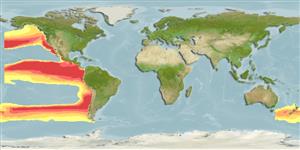>
Anguilliformes (Eels and morays) >
Nettastomatidae (Duckbill eels)
Etymology: Facciolella: Latin, diminutive of falx, falcis = sickle (Ref. 45335).
Eponymy: Dr Luigi Facciolà (1851–1943) was an Italian physician and ichthyologist who was the first to recognise and describe the Witch-Eel genus (1911) but in doing so used a preoccupied name (Nettastomella). [...] (Ref. 128868), visit book page.
More on author: Gilbert.
Environment: milieu / climate zone / depth range / distribution range
Ecología
marino batipelágico; rango de profundidad 64 - 1000 m (Ref. 96339). Deep-water
Eastern Central Pacific: Point Conception, California, USA to Panama, and Guadalupe and Galapagos Islands.
Tamaño / Peso / Age
Maturity: Lm ? range ? - ? cm
Max length : 90.0 cm TL macho / no sexado; (Ref. 28023)
Short description
Claves de identificación | Morfología | Morfometría
Color uniformly brown.
Feeds on small deep-sea crustaceans (Ref. 28023). Caught well offshore in pelagic waters to depths of several hundred meters (Ref. 28023).
Life cycle and mating behavior
Madurez | Reproducción | Puesta | Huevos | Fecundidad | Larva
Grove, J.S. and R.J. Lavenberg, 1997. The fishes of the Galápagos Islands. Stanford University Press, Stanford, 863 p. (Ref. 28023)
IUCN Red List Status (Ref. 130435: Version 2024-1)
Threat to humans
Harmless
Human uses
Pesquerías: sin interés
Herramientas
Special reports
Download XML
Fuentes de Internet
Estimates based on models
Preferred temperature (Ref.
123201): 7.1 - 13.4, mean 9.6 °C (based on 59 cells).
Phylogenetic diversity index (Ref.
82804): PD
50 = 0.5156 [Uniqueness, from 0.5 = low to 2.0 = high].
Bayesian length-weight: a=0.00089 (0.00036 - 0.00222), b=2.98 (2.76 - 3.20), in cm total length, based on LWR estimates for this (Sub)family-body shape (Ref.
93245).
Nivel trófico (Ref.
69278): 3.1 ±0.30 se; based on food items.
Resiliencia (Ref.
120179): Medio, población duplicada en un tiempo mínimo de 1.4-4.4 años (tm=4).
Fishing Vulnerability (Ref.
59153): High vulnerability (56 of 100).
